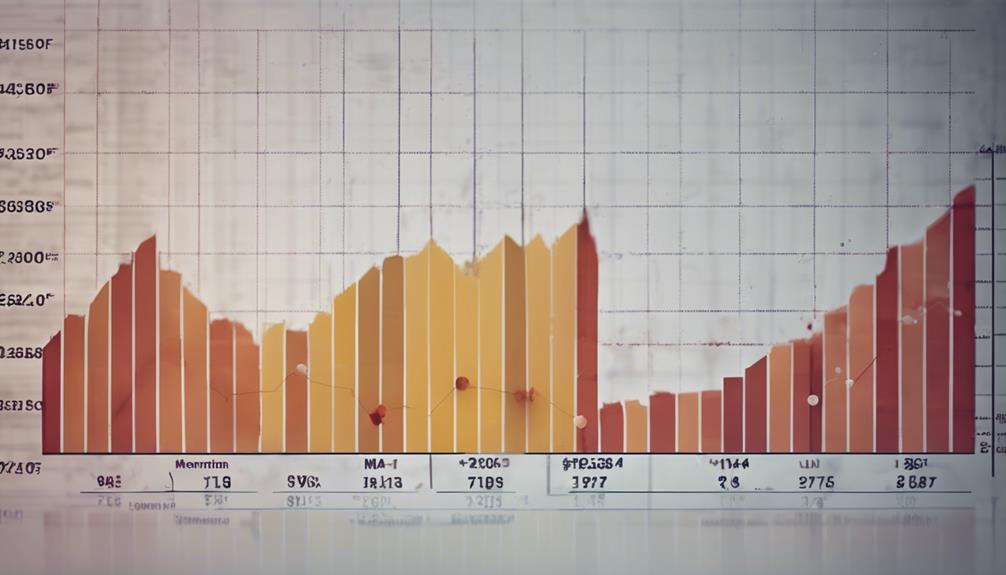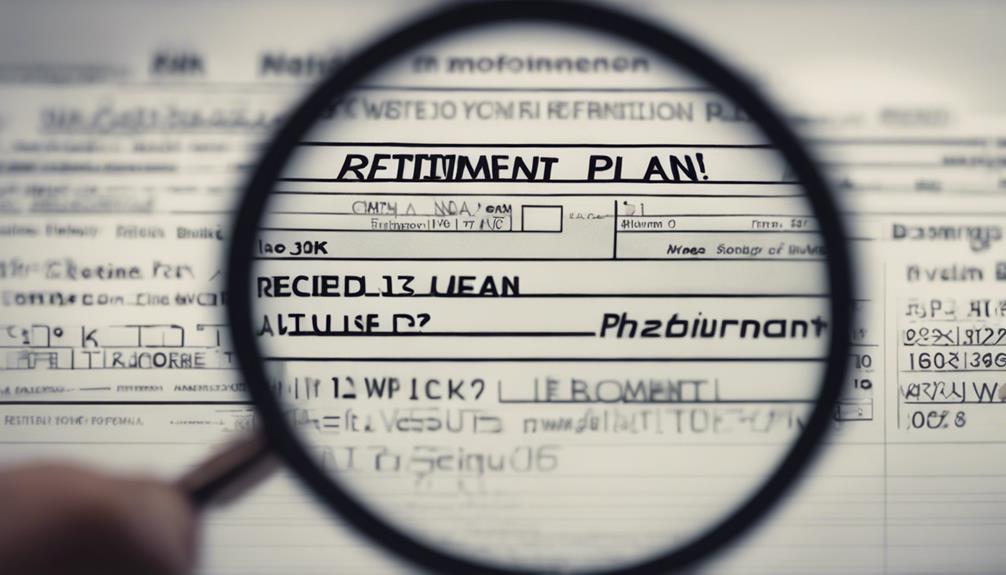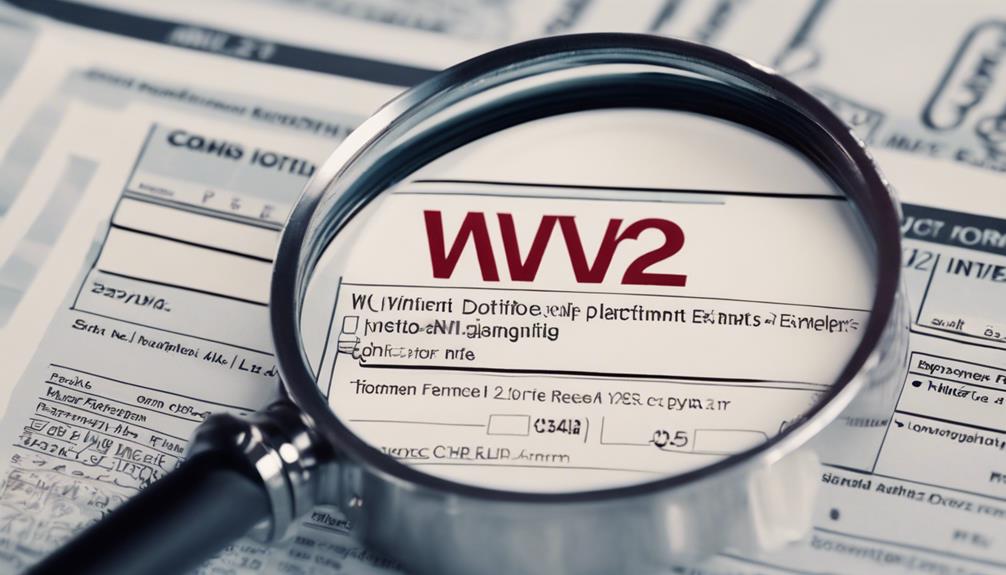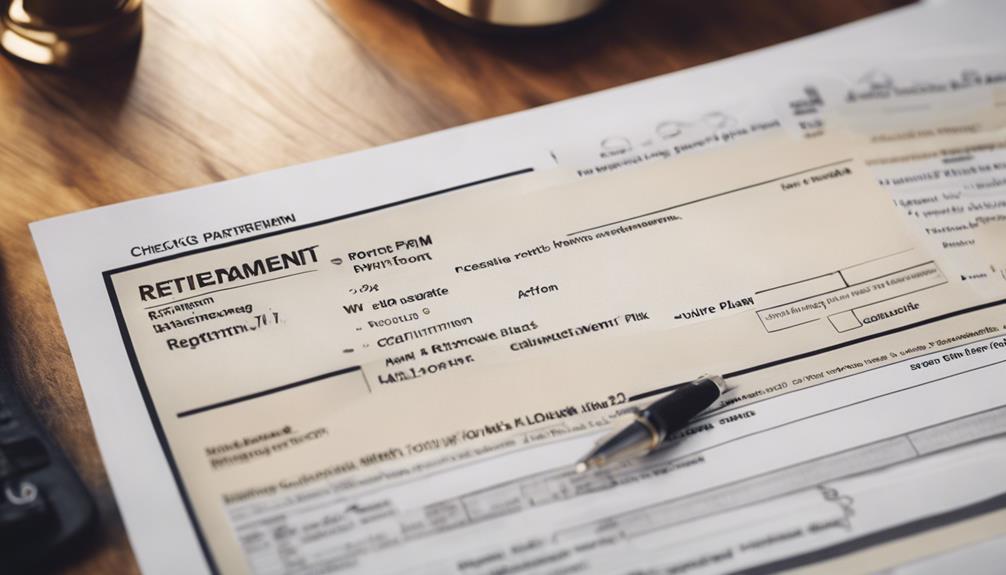IRA Investment Strategies
Selecting the Right Inflation Rate for Retirement Planning
Get a handle on retirement planning by choosing the right inflation rate to protect your savings – your financial future depends on it!

When preparing for retirement, choosing the right inflation rate is essential to protect your savings for a stable financial future. Inflation can weaken the buying power of your retirement funds, especially if you have a fixed income. Experts recommend considering a 2-2.5% inflation rate, as higher rates can significantly reduce savings. Diversifying your investments across different asset classes can help counteract the impact of inflation. By analyzing historical trends, economic forecasts, and personal spending habits, you can make informed decisions to ensure your retirement savings keep up with inflation and preserve your financial security. Consider seeking professional advice for personalized retirement planning guidance.
Key Takeaways
- Historical trends suggest using a 2.5% average inflation rate for retirement planning.
- Realistic projections may require adjusting inflation rates by 12-20%.
- Understanding inflation helps make informed financial decisions for retirement.
- Reliable inflation data aids in making sound choices for retirement savings.
- Personal spending impacts, especially healthcare costs, should be considered when selecting an inflation rate.
Understanding Inflation's Impact on Retirement

Inflation chips away at your retirement savings, leaving you with less purchasing power over time. As you plan for retirement, it's important to take into account how inflation can impact your fixed retirement income.
A modest 2-2.5% inflation rate may seem small, but it can greatly erode the value of your savings, especially for individuals aged 60 to 85. For instance, a $1 million retirement account could shrink substantially over five years with a 3.7% inflation rate, dropping to $828,193.
This decrease in purchasing power could limit your ability to cover essential expenses, particularly as healthcare costs tend to rise faster than the Consumer Price Index (CPI). Consulting a financial advisor to navigate inflation's effects on your retirement income and exploring diverse asset classes to hedge against inflation can help safeguard your financial well-being in retirement.
Stay informed about how inflation impacts your purchasing power and adjust your retirement plan accordingly to mitigate its effects on your financial stability.
Historical Trends and Economic Forecasts

Examining historical trends and economic forecasts provides valuable insights into the factors influencing retirement planning decisions. To make informed financial decisions regarding retirement, understanding the inflation rate is essential.
Consider the following:
- Historical Average: The average Consumer Price Index (CPI) over the last century has been 3.21%. This historical data can serve as a reference point for long-term inflation trends.
- Economic Forecasts: Economic experts commonly use a 30-year average inflation rate of around 2.5% for retirement planning projections. This rate is based on economic forecasts and helps in estimating future expenses.
- Adjusting for Realism: It may be prudent to adjust the 30-year average CPI by 12% to 20% to account for fluctuations and uncertainties. This adjustment can help create more realistic retirement projections and mitigate potential retirement risks.
Considering these historical trends and economic forecasts can assist you in making sound retirement decisions based on reliable inflation rate data.
Personal Spending Considerations

To guarantee your retirement funds adequately cover essential expenses like housing, healthcare, and food, understanding how inflation impacts personal spending is important. Inflation rates can greatly affect the cost of living, especially in areas such as health care, which tends to experience higher inflation rates than other goods and services.
Rising costs can erode the purchasing power of your retirement savings, impacting your standard of living in retirement. It's vital to take into account these factors when budgeting for retirement to maintain financial stability over the long term.
Adjusting Investment Allocations

Exploring different asset classes like stocks, real estate, commodities, and Treasury Inflation-Protected Securities (TIPS) can be effective in adjusting investment allocations to combat the impact of higher inflation. To adjust for inflation and mitigate inflation risk, here are three key steps to contemplate:
- Invest in Stocks: Stocks have historically outperformed inflation, offering the potential for higher returns that can outpace rising prices. Including stocks in your investment portfolio can help boost your overall rate of return and protect your investments against the erosive effects of inflation.
- Allocate to Real Estate: Real estate investments can act as a hedge against inflation by typically appreciating in value over time. Investing in properties or real estate investment trusts (REITs) can provide a source of income that adjusts with inflation, helping to maintain your purchasing power.
- Consider Commodities: Commodities like gold and oil can offer diversification benefits to your portfolio and serve as a store of value during inflationary periods. Including commodities can help balance your investment allocations and reduce the impact of inflation on your overall returns.
Savings Goals and Insurance Coverage

Adjusting your investment allocations can help you meet your savings goals and secure the right insurance coverage for retirement planning. It's important to determine your savings goals based on expected inflation rates to make sure you have sufficient funds for retirement.
Considering insurance options like long-term care insurance is vital to safeguard against rising healthcare costs in retirement. When planning for retirement, it's vital to adjust your retirement plan to take into account inflation rates, which historically average around 2.5% over 30 years.
Regularly reviewing your budget is key to aligning it with your desired standard of living and factoring in potential inflation increases. Seeking professional advice can help you assess how different inflation rates may impact your retirement savings and insurance needs, ensuring you're well-prepared for the future.
Achieving Long-Term Financial Security

Achieve long-term financial security by carefully selecting an appropriate inflation rate for your retirement planning. To secure your financial future, consider the following:
- Account for Higher Costs: Recognize that as you age, healthcare expenses tend to increase. Adjust your income plan to accommodate these rising costs by factoring in a realistic inflation rate assumption.
- Monitor Inflation Rates: Stay informed about Consumer Price Index (CPI) rates and how they may impact your retirement savings. Regularly reassess and adjust your financial strategies to align with changing economic conditions.
- Preserve Your Standard of Living: Make sure that your retirement income plan reflects the inflationary pressures that could erode your purchasing power over time. By selecting an appropriate inflation rate, you can safeguard your standard of living during retirement and mitigate the risk of outliving your savings.
Frequently Asked Questions
What Rate of Inflation Should I Use for Retirement Planning?
For retirement planning, consider using an inflation rate around 2.5%. This rate aims to balance historical trends and recent data, providing a reasonable estimate for long-term projections.
However, adjustments may be necessary based on individual circumstances, such as housing costs and lifestyle choices. By incorporating these factors, you can create a more accurate financial plan that reflects the real-world expenses you may encounter during retirement.
Does the 4% Rule Consider Inflation?
In retirement planning, the 4% rule doesn't explicitly consider inflation adjustments. Over time, inflation can diminish the purchasing power of fixed withdrawals, impacting your financial security.
To sustain your lifestyle, you may need to adjust withdrawals for inflation. By accounting for inflation, you can better guarantee long-term financial stability during retirement.
What Rate of Return Should I Use for Retirement Planning?
When planning for retirement, consider a rate of return around 6-8% to accommodate inflation and grow your investments over time. This range allows for potential increases in purchasing power while balancing the impact of inflation on expenses.
Adjust your retirement projections regularly to guarantee they align with your financial goals and account for fluctuations in the economy. Monitoring and adapting your plan as needed will help you achieve a realistic and sustainable retirement strategy.
What Inflation Rate Do Financial Advisors Use?
Financial advisors often use a 30-year average inflation rate around 2.5% for retirement projections. This rate, based on the Consumer Price Index, helps estimate future costs accurately.
Remember, housing expenses, a significant part of the CPI, play a pivotal role in retirement planning. Adjustments of 12% to 20% may be necessary to the CPI average for more precise projections.
Historical data shows an average inflation rate of approximately 3.21% based on the CPI.
Conclusion
To sum up, selecting the appropriate inflation rate for retirement planning is essential for maintaining your purchasing power over time. By considering historical trends, personal spending habits, and adjusting your investment allocations, you can better prepare for the future.
It's like choosing the right gear for a long journey – each decision impacts your overall financial security. Stay informed, stay proactive, and secure your retirement with careful consideration of inflation's impact.
IRA Investment Strategies
How to Cash Out Your Retirement Plan
Juggle the potential penalties and tax implications when cashing out your retirement plan – discover how to navigate wisely for optimal savings.

When withdrawing funds from your retirement account, it’s important to be mindful of the potential penalties and tax consequences. Early withdrawals may result in a 10% IRS penalty, which can have a negative impact on your long-term savings. One option to consider is converting to an IRA for greater flexibility. It’s advisable to seek advice from a financial advisor before making any decisions, as penalties can eat into your savings and lead to owed ordinary income tax. There are exceptions for penalty-free withdrawals in certain cases. Consulting with a financial advisor can provide personalized guidance and help you explore alternatives like rollovers. It’s crucial to understand how these decisions can affect your retirement savings in the long run and to consider strategies for maximizing your savings. By making informed financial decisions that align with your goals, you can effectively optimize your retirement savings.
Key Takeaways
- Contact your plan administrator for cash-out procedures.
- Complete necessary forms for prompt access to funds.
- Understand tax implications and potential penalties.
- Consider rolling over funds to an IRA for flexibility.
- Seek guidance from a financial advisor for optimal decisions.
Early Withdrawal Considerations

Consider the implications of withdrawing funds early from your retirement plan. When you withdraw money before the age of 59.5, you may face a 10% penalty on top of regular income taxes. One way to potentially avoid penalties and have more flexibility in withdrawals is by converting your 401(k) to an IRA.
Keep in mind that hardship withdrawals for specific financial needs are exempt from the 10% penalty but are still subject to income tax.
Taking money out of your retirement account prematurely can have a long-term impact on your financial future. Early withdrawals can greatly reduce the growth potential of your retirement savings, affecting your ability to secure a comfortable retirement.
Before deciding to cash out your retirement plan early, it's important to explore all alternatives and seek advice from a financial advisor. They can help you understand the tax implications and provide guidance on the best course of action based on your individual circumstances.
Potential Penalties and Taxes

When contemplating cashing out your retirement plan early, it's important to understand the potential penalties and taxes involved.
The IRS may impose a 10% penalty on withdrawals made before age 59.5, in addition to regular income taxes.
Such early withdrawals can diminish your retirement savings greatly, impacting your long-term financial security.
Tax Implications on Withdrawals
Early withdrawals from retirement plans, such as a 401(k), before reaching age 59.5 may trigger a 10% tax penalty along with potential ordinary income taxes owed on the withdrawn amount. The IRS penalties can greatly impact your finances when cashing out a retirement plan prematurely.
Seeking advice from a financial advisor before making this decision is vital to fully understand the implications. Cashing out early may seem appealing, but it's important to ponder the long-term consequences. By withdrawing funds early, you not only face immediate tax implications but also risk reducing your future savings.
Make sure to weigh the pros and cons carefully, factoring in both the penalties and taxes involved.
Early Withdrawal Penalties
Incurring a 10% penalty from the IRS is a significant consequence of withdrawing early from a retirement plan before reaching age 59.5. This penalty is in addition to the regular income taxes owed on the withdrawn amount.
Early withdrawals can have a substantial financial impact, reducing retirement savings due to penalties and lost growth potential. However, there are exceptions for penalty-free withdrawals in specific situations like disability or medical expenses.
It's important to carefully consider the implications of early withdrawals on your retirement funds. By withdrawing early, you not only face the 10% penalty but also risk diminishing the amount available for your retirement years. Make informed decisions to safeguard your financial future.
Exceptions for Penalty-Free Withdrawals

If you're considering cashing out your retirement plan early, keep in mind that there are exceptions for penalty-free withdrawals that you might qualify for.
These exceptions include early retirement options and specific hardship withdrawal criteria.
Understanding these exceptions can help you navigate the process and make informed decisions about your finances.
Early Retirement Options
When considering your retirement options, certain circumstances may allow you to make penalty-free withdrawals from your retirement plan. Leaving your job at age 55 or later qualifies you for early retirement options without penalties.
Dividing a 401(k) during a divorce also enables penalty-free withdrawals. Additionally, exemptions for penalty-free withdrawals exist for situations like terminal illness, disability, or surviving domestic abuse.
Opting for substantially equal periodic payments can be another strategy to avoid penalties on early withdrawals. These exceptions for penalty-free withdrawals provide flexibility and support in various challenging situations, ensuring you can access your retirement funds when needed without incurring unnecessary penalties.
Hardship Withdrawal Criteria
Curious about the criteria for hardship withdrawals that allow penalty-free access to your retirement funds?
Hardship withdrawals are designed to assist in cases of immediate financial need. Qualifying reasons for hardship withdrawals include expenses such as medical costs, education fees, or preventing eviction.
While hardship withdrawals are subject to income tax, they're exempt from the 10% early withdrawal penalty typically associated with early withdrawals from retirement accounts.
When applying for a hardship withdrawal, you may need to provide proof of the financial need and show that you're unable to obtain the required funds from other sources. Remember that the amount you can withdraw is limited to what's necessary to cover the specific financial need you're facing.
Consult a Financial Advisor

Consider consulting a financial advisor for personalized guidance on cashing out your retirement plan. A financial advisor can help you navigate the complex landscape of tax implications and penalties associated with early withdrawals from your retirement savings.
They can also assist you in exploring alternative options, such as rollovers or loans, to avoid unnecessary financial setbacks. By working with a financial advisor, you can create a long-term financial plan that aligns with your retirement goals, ensuring that you make informed decisions about your financial future.
Their expertise can provide you with valuable insights and strategies to optimize your retirement savings while minimizing risks. Consulting a financial advisor is a proactive step towards securing your financial stability and making sound financial choices that will benefit you in the long run.
Withdrawing Before Retirement Age

Before taking an early withdrawal from your retirement plan, be mindful that you might face a 10% penalty along with regular income taxes. These penalties can greatly impact the growth of your retirement savings over time.
It's important to carefully consider the long-term consequences of withdrawing before reaching retirement age.
Early Withdrawal Penalties
Withdrawing from your retirement account before reaching age 59.5 may incur a 10% penalty on top of regular income taxes. These early withdrawal penalties can have a significant impact on your finances, as they not only reduce your immediate cash-out amount but also diminish the account's growth potential.
For instance, a $5,000 withdrawal at age 30 could potentially grow to over $33,000 by age 60 if left untouched, highlighting the long-term impact of early withdrawals. It's essential to view cashing out your retirement plan early as a last resort due to the penalties involved and the loss of compound interest and growth potential.
Evaluate the consequences carefully before deciding to proceed with an early withdrawal.
Tax Implications
If you withdraw funds from your retirement account before reaching age 59.5, be aware that you may face a 10% tax penalty along with regular income taxes. Early withdrawals can have a significant long-term impact on the growth potential of your retirement savings and financial security. Seeking advice from a financial advisor is essential to understand the tax implications and consequences of tapping into your retirement savings prematurely. Here is a table highlighting key points regarding the tax implications of early distributions from retirement accounts:
| Key Points | Description |
|---|---|
| Tax on Early Distributions | 10% penalty and regular income taxes apply |
| Long-term Impact | Diminishes growth potential of retirement savings |
| Financial Advisor Consult | Vital to comprehend tax implications and potential financial outcomes |
| Retirement Savings | Withdrawals can deplete resources intended for retirement |
| Financial Security | Early withdrawals may jeopardize future financial stability |
Strategies for Maximizing Savings

To maximize your savings in retirement, consider diversifying your investments within your retirement plan to reduce risk and potentially boost returns. By spreading your investments across different asset classes like stocks, bonds, and real estate, you can minimize the impact of market fluctuations on your overall portfolio. Additionally, think about rolling over your 401(k) to an IRA for increased investment flexibility and control over your retirement savings. This move allows you to choose from a broader range of investment options tailored to your financial goals and risk tolerance.
When changing jobs, enrolling in your new employer's 401(k) plan can help you avoid taxes and penalties associated with cashing out your retirement plan. Be mindful of tax implications and make timely transfers of funds within 60 days to prevent any adverse consequences. If you're over 72 years old, start taking distributions or consider rolling over your retirement savings to a new employer's plan to stay compliant with regulations and maximize your savings for the future.
Cashing Out After Job Termination

Consider cashing out your retirement plan after job termination, even before reaching age 59 ½, by contacting the plan administrator to initiate the process. Completing distribution forms is essential to start the cash-out procedure and access your funds promptly.
However, keep in mind that an early withdrawal without a rollover could lead to a 10% penalty imposed by the IRS. To avoid this penalty and potential tax implications, explore the option of transferring your funds to a new employer's 401(k) plan.
Tax Implications of Cashing Out

After cashing out your retirement plan following job termination, understanding the tax implications is crucial to managing your overall financial situation effectively.
When you withdraw funds early, you may face a 10% early withdrawal penalty in addition to regular income taxes. This can greatly impact your tax liability for the year.
Additionally, taking money out of your retirement plan prematurely reduces the potential for long-term growth and compound interest to work in your favor.
To mitigate immediate tax consequences, consider rolling over the funds into an IRA. By doing so, you can defer paying taxes until you make withdrawals in the future.
It's advisable to consult a tax professional or financial advisor to grasp the specific tax consequences associated with cashing out your retirement accounts. Their expertise can provide valuable insights into how this decision fits into your overall financial strategy and retirement planning for the future.
Rollover Options and Guidance

Discover various options for rolling over your retirement plan to guarantee you make well-informed decisions about your financial future.
When considering rollover options, you can:
- Transfer funds to a new employer's plan for consolidated management.
- Set up an IRA for increased investment flexibility and control.
- Evaluate the tax implications and fees associated with each rollover choice.
- Explore the benefits of a Roth IRA conversion for potential tax advantages.
Tips for Smart Withdrawal Planning

When planning your retirement withdrawals, it's vital to carefully assess the tax implications and potential penalties to make informed decisions about your financial future. Understanding the rules and regulations governing withdrawals from your retirement plan is pivotal to avoid unexpected tax liabilities or penalties.
Early withdrawals can incur hefty penalties, impacting your long-term financial goals significantly. Before cashing out, consider the tax implications on your overall retirement savings and assess whether alternative options like rollovers or loans might better suit your needs.
Smart withdrawal planning involves weighing the immediate financial need against the potential long-term consequences. By taking the time to evaluate all available options and understanding the implications of each choice, you can make a more informed decision that aligns with your financial objectives.
Prioritize your long-term financial security by planning your withdrawals strategically and in accordance with the regulations to maximize your retirement savings.
Frequently Asked Questions
Can I Close My 401K and Take the Money?
You can close your 401(k) and take the money, but it may come with taxes and penalties. Withdrawing before retirement age can impact long-term savings. Consult a financial advisor before cashing out to understand implications.
Consider options like rolling over to an IRA to avoid immediate taxes. Early withdrawals may incur a 10% penalty on top of regular income taxes. Prioritize making informed decisions about your retirement funds.
Is It Ever a Good Idea to Cash Out Retirement?
Cashing out retirement funds should be a last resort due to penalties and potential long-term financial setbacks. It's generally not advisable as it can greatly reduce your savings and jeopardize your retirement security.
Exploring other options like personal loans or financial aid is recommended before tapping into your retirement account. Consult a financial advisor to fully understand the implications and explore alternatives to preserve your retirement funds for the future.
How to Access Retirement Funds Early?
To access retirement funds early, consider exceptions like disability or medical expenses for penalty-free withdrawals. Dividing a 401(k) in a divorce could also provide access without penalties.
Strategies such as substantially equal periodic payments help avoid penalties. Converting a 401(k) to an IRA may offer tax advantages when accessing funds early.
Be mindful of the 10% penalty for early withdrawals before age 59.5 unless you meet specific criteria.
How Can I Take My Money Out of My 401K Without Quitting My Job?
If you want to access your 401(k) funds without quitting, consider taking a loan, subject to repayment with interest within five years.
For immediate needs, explore hardship withdrawals, but be aware of income taxes. Early withdrawals before 59.5 years old incur a 10% penalty.
Consult your plan administrator for options. Evaluate the consequences of cashing out early for informed decisions regarding your retirement savings.
Conclusion
In wrapping up, when it comes to cashing out your retirement plan, it's important to take into account early withdrawal penalties, tax implications, and rollover options.
By seeking guidance from a financial advisor, you can make informed decisions that align with your long-term financial goals.
Whether you're withdrawing before retirement age or cashing out after a job termination, careful planning and understanding the potential consequences are key to maximizing your retirement savings.
Remember, smart withdrawal planning is essential for securing your financial future.
IRA Investment Strategies
Locating Your Retirement Plan on Your W2
Find your retirement plan on your W-2 by focusing on Box 12 codes like D and E, essential for optimizing your savings – learn more for financial success.

To find your retirement plan on your W-2, look at Box 12 which contains specific codes for different contributions. Codes such as D for 401(k) or E for 403(b) represent various retirement savings. Your employer uses these codes to report the contributions made on your behalf. Identifying these codes will help you keep track of and better understand your retirement plan. By interpreting these codes, you can maximize your retirement savings effectively. If you want to make the most of your retirement plan, it is crucial to pay attention to these codes. Further information on how to maximize your retirement savings can be found in the detailed breakdown of retirement plan contributions.
Key Takeaways
- Check Box 12 on W-2 for retirement plan codes like D, E, F, G, or H.
- Understand the retirement plan codes to identify specific contributions accurately.
- Contact former employers to inquire about old 401(k) plans.
- Review Box 13 on W-2 for Retirement plan indicator affecting IRA deductions.
- Utilize Box 12 and Box 13 details for tracking and managing retirement savings.
Understanding Form W-2 Codes

If you've ever wondered what those mysterious codes like D, E, F, G, and H on your Form W-2 mean, you're not alone. These codes represent specific types of retirement plan contributions made by your employer.
For example, code D signifies elective deferrals under a 401(k) plan, while code E indicates salary deferred under a 403(b) agreement. Employers use these codes in Box 12 of your W-2 form to report different retirement plan contributions that have been made on your behalf.
Understanding these codes is essential as it helps you identify and track the retirement plan contributions being made for you. By recognizing these codes, you can have a clearer picture of how much is being contributed towards your retirement savings. This knowledge allows you to monitor your retirement plan effectively and make informed decisions regarding your financial future.
Identifying Retirement Plan Employers

When reviewing your W-2, focus on identifying key information about your retirement plan employers.
Look for details on:
- employer contributions summary,
- plan participation specifics, and
- the vesting schedule overview.
Understanding these points will help you gain insight into your retirement plan and make informed financial decisions for the future.
Employer Contributions Summary
Identifying Retirement Plan Employers can be accomplished by locating employer contributions in designated sections of your W-2 form or additional plan documents. Employer contributions towards retirement plans are crucial for boosting retirement savings. These contributions are usually not found in Box 12 of the W-2 form but may be detailed in sections like Box 13 or in supplemental documents.
Understanding employer contributions is essential for evaluating the overall value of your retirement benefits. To verify these contributions, review annual statements or seek guidance from the plan administrator. By recognizing and comprehending the significance of employer contributions, you can make informed decisions regarding your retirement planning and financial future.
Plan Participation Details
To comprehend the retirement plan participation details and identify your retirement plan employers, focus on the codes in Box 12 of your W-2 form, particularly looking for code D related to 401(k) contributions. By examining this code, you can determine the amount of elective deferrals you made towards your retirement plan for the year. Below is a table summarizing the key information related to retirement plan participation details:
| Code | Description | Amount |
|---|---|---|
| D | 401(k) contributions | $X,XXX.XX |
Understanding these details is essential for evaluating the impact on your taxes and overall retirement plan. Remember, professional advice can offer further clarification on your retirement plan contributions.
Vesting Schedule Overview
Start by examining your retirement plan documents or reaching out to HR to understand the vesting schedule, which indicates when you gain full ownership of employer-contributed funds. A vesting schedule in a retirement plan outlines how ownership of these funds accrues over time. It can be immediate, cliff-vested (where ownership occurs all at once after a certain period), or graded (where ownership increases gradually).
Employers may have different vesting schedules for their contributions compared to employee contributions. Knowing your vesting schedule is essential for deciding how much of your retirement funds you can take if you switch jobs. To get specific details about your vesting schedule, review your retirement plan documents or consult your HR department.
Contacting Plan Sponsors

When reaching out to plan sponsors about your retirement plan, consider contacting the human resources department or benefits administrator at your previous employer for assistance. If you're unsure which employers you had a retirement plan with, reviewing old W-2 tax forms can help you identify them.
These forms usually list employers who offered retirement plans, providing valuable information to help you reach out to the right plan sponsors. Additionally, keep an eye on your mail for any quarterly or yearly statements related to your old 401(k) that may have been sent to you.
It's also a good idea to search nationwide databases for unclaimed retirement plan balances, as you may find yourself listed as a missing participant. For more detailed information and additional contact details about your retirement plan, you can utilize the Department of Labor's Form 5500 database.
Reaching Out to Previous Employers

If you want to gather information about your old 401(k) plan, reach out directly to your previous employers, starting with the department overseeing company benefits or human resources.
Here's how you can go about it:
- Contact the Company Benefits Department: Initiate contact with the department responsible for employee benefits within your previous employers' organization.
- Reach Out to Human Resources: Human resources departments often handle retirement plans, making them a good starting point for inquiries.
- Use W-2 Forms and Employment Records: Refer to old W-2 tax forms and review past employment records to identify employers with whom you had a retirement plan.
Checking for 401(k) Account Updates

To stay informed about any updates to your 401(k) account, regularly review the information provided in Box 12 of your W2 form. In Box 12, specific codes like D indicate elective deferrals under a 401(k) plan. By checking the amount listed next to the code, you can understand the total contributions made to your 401(k) account. This information is vital for evaluating the growth of your retirement savings and planning for the future.
Additionally, understanding the tax implications of your 401(k) contributions is essential for effective financial planning. Knowing how much of your income is going towards your 401(k) can impact your tax withholding and overall financial strategy. If you have any questions or need assistance in maximizing the benefits of your 401(k) contributions, consider seeking professional advice to make the most of your retirement savings opportunities.
Reviewing Mail for Account Statements

When managing your retirement plan, it's essential to check your mail regularly for account statements. Take the time to review these statements for accuracy and important updates about your old 401(k).
Organize the statements chronologically to track your previous contributions effectively.
Check Mail Regularly
Regularly reviewing your mail for account statements is essential for staying informed about your old 401(k) plan. Here are some key points to keep in mind:
- Check for Updates: Keep an eye out for quarterly or yearly statements regarding your old 401(k) account.
- Contact Former Employers: If you're missing information, reach out to your previous employers for assistance.
- Stay Informed: Review these documents carefully to gather important details about your retirement plan.
Review for Accuracy
Keep a close eye on your mailbox for any statements related to your old 401(k) plan to guarantee accuracy in reviewing your retirement account information. These statements could include important details about your retirement savings, such as your current balance, investment performance, and any fees associated with the account.
One vital document to look out for is your Wage and Tax Statement, which may contain information about contributions made to your 401(k) plan during the year. By carefully reviewing these statements, you can make certain that all the information aligns with your expectations and take action if you notice any discrepancies.
Stay vigilant in checking your mail for these updates to stay informed about your old 401(k) plan's status.
Organize Statements Chronologically
To effectively organize your account statements chronologically, begin by sorting them by date. When reviewing mail for account statements related to your compensation plan, follow these steps:
- Check for updates or statements from past employers regarding your retirement plan.
- Look for any correspondence related to your old 401(k) that was sent to you.
- Keep an eye out for any documentation that could help you locate details about your retirement account.
Common Errors in Retirement Plan Codes

When reporting retirement plan codes on Form W-2, ensure accuracy to avoid potential tax implications and confusion for employees due to common errors. Common errors in retirement plan codes, such as incorrectly using codes like D, E, F, G, and H, can lead to discrepancies.
Mistakes often arise when codes are applied to the wrong types of contributions or plans, causing confusion for both employers and employees. These inaccuracies may result in unintended tax consequences for employees.
To mitigate these issues, it's important for employers to meticulously review and guarantee the precise reporting of retirement plan codes on Form W-2. Understanding the correct codes and their corresponding meanings is essential in preventing errors that could impact employee tax reporting.
Clarifying Form W-2 Box 13

Form W-2 Box 13 holds the Retirement plan indicator, which clarifies if you're an active participant in your company's plan. It's important as it helps determine traditional IRA deduction limitations and lists various qualified retirement plans you may be part of.
Confirm accurate information in this box, as non-qualified or 457(b) plans shouldn't be marked.
Box 13 Explanation
On your W-2 form, Box 13 clarifies your active participation in your employer's retirement plan. This box indicates whether you were part of a retirement plan at work during the tax year. Here's what you need to know about Box 13:
- Checking the retirement plan indicator in Box 13 informs about possible IRA deduction limitations.
- Box 13 should be checked if you participated in various qualified retirement plans.
- Active participant status is determined by coverage under defined contribution or benefit plans.
Understanding Box 13 is important as it impacts how your retirement contributions are handled for tax purposes. Make sure to review this section carefully to ensure accurate reporting of your retirement plan status.
Retirement Plan Indicator
Understanding the Retirement Plan Indicator in Box 13 of your W-2 form is crucial for determining your active participation in your employer's retirement plan. This retirement plan box signifies if you're part of your company's retirement plan, affecting your eligibility for traditional IRA deductions. If you have contributed to plans like 401(k), profit-sharing, or SEP plans, this box should be checked.
Being an active participant depends on your coverage under defined contribution or benefit plans such as a 401(k). However, please be aware that non-qualified or 457(b) plans don't require checking the retirement plan box on Form W-2.
Make sure to review this indicator carefully to understand your involvement in the retirement plan and its implications for your deductions.
Recognizing Active Participant Status

When determining if you're an active participant in a retirement plan, look for the indicator marked on your Form W-2. Being marked as an active participant means you're covered by a defined contribution or benefit plan, usually based on eligibility for participation in 401(k) or other defined benefit plans.
However, non-qualified or 457(b) plans don't qualify for this marking. This status can also impact the limitations on deductions for traditional IRAs. Employers mark the retirement plan box for employees enrolled in various IRS-qualified plans, signifying active participation status.
Understanding this status is essential for managing your retirement savings effectively. Make sure to check your Form W-2 for this indicator to stay informed about your retirement plan status.
Tips for Locating Previous 401(k) Accounts

To track down your previous 401(k) accounts, start by checking Box 12 on your W-2 form for relevant retirement plan codes. Look for code D, which indicates 401(k) elective deferrals. The amount next to this code shows your contributions to the 401(k) account.
Understanding these codes and amounts in Box 12 will help you identify and track your previous 401(k) account details effectively. Reviewing your W-2 form annually can assist in monitoring your retirement plan contributions over time.
If you need more information about your old 401(k) accounts, consider reaching out to your former employers based on the details found in Box 12 of your W-2. By utilizing these tips and staying informed about your retirement plan contributions, you can better manage and track your previous 401(k) accounts for a secure financial future.
Frequently Asked Questions
How Do I Find My Retirement Plan on My W-2?
To find your retirement plan on your W-2, look for Box 12. Codes like D indicate 401(k) contributions. Check the amount next to code D for the total.
Understanding these contributions helps with financial planning and taxes. For more help, talk to a financial or tax professional.
What Box on W-2 Shows Retirement Contributions?
Box 12 on your W-2 displays retirement contributions. It includes codes like D for 401(k) elective deferrals. Each code corresponds to the amount of salary deferred under your retirement plan.
Checking Box 13 confirms if you actively participate in the plan. Reviewing these boxes provides a breakdown of your retirement contributions and participation status.
These sections on your W-2 help you understand your retirement savings and involvement in the plan.
How Do I Know What Retirement Plan I Have?
To determine your retirement plan, review your W-2 Box 12 codes, like D for 401(k) or E for 403(b). These codes indicate the type of plan you're enrolled in.
Analyzing these codes helps you identify your specific retirement contributions deducted from your salary. Understanding these codes clarifies your retirement plan and guides you in managing your contributions effectively.
Check your W-2 for these codes to gain insight into your retirement savings strategy.
What Is DD in Box 12 of W-2?
DD in Box 12 of your W-2 indicates the cost of employer-sponsored health coverage. This amount isn't taxable and serves as an informational insight into the value of your health benefits.
Employers include this to help you understand the worth of the health coverage they provide. It's a transparent way for them to show you how much your health insurance costs and its significance.
Conclusion
Now that you have decoded your W-2 and located your retirement plan, you're one step closer to securing your financial future.
By reaching out to plan sponsors and previous employers, you can make sure that your retirement savings are in order.
Remember, a little effort now can lead to a comfortable retirement later on.
Take control of your financial destiny and watch your retirement plan grow like a well-tended garden.
IRA Investment Strategies
How to Determine Your Retirement Rate of Return for Future Planning
Curious about calculating your retirement rate of return? Discover essential factors and expert tips for effective future planning.

To calculate your future retirement rate of return for planning purposes, take into account factors such as risk tolerance, types of investments, and length of time. Review historical returns on various asset classes to gain insights, such as large US stocks which returned 10% from 1926 to 2020. Investments made before retirement typically yield 6%, while those made after retirement usually offer 5%. Inflation rates of around 3% are crucial for projections. Diversify your investments and consider seeking professional advice to maximize your retirement returns. Aim for conservative estimates like the 5% returns recommended by experts. Use retirement calculators to get personalized projections based on average return rates. Mastering these steps is essential for successful retirement planning.
Key Takeaways
- Assess risk tolerance to determine asset allocation and long-term strategies.
- Consider investment types like stocks, bonds, and REITs for varied returns.
- Factor in retirement timeline length to influence portfolio performance.
- Understand compound interest and annualized returns for growth projections.
- Align rate of return projections with risk tolerance and inflation rates.
Factors Influencing Retirement Rate of Return

Factors that influence your retirement rate of return include your risk tolerance, choice of investment types, and the length of your retirement timeline. Your risk tolerance impacts how you allocate your assets and the long-term strategies you employ, shaping the rate of return in your retirement planning.
Different investment types like stocks, bonds, mutual funds, ETFs, and REITs come with unique features and fee structures that directly affect the rate of return you can expect. Additionally, the duration of your retirement timeline plays a significant role in determining your portfolio performance based on market conditions and the investment strategies you choose.
Understanding the difference between annualized and compounding returns is essential for accurately projecting your income in retirement. Market indexes like the S&P 500 exhibit fluctuating returns, necessitating consideration to assess historical performance and predict potential future returns.
Historic Asset Class Returns Analysis

Analyzing historic asset class returns provides valuable insights into the performance of various investment options over specific time frames. When examining historic returns, it's essential to take into account the average annual return of different asset classes:
- Large US stocks had an average annual return of about 10% from 1926 to 2020, highlighting strong performance over the long term.
- Small US stocks, on the other hand, showed an average annual return of around 11% during the same period, suggesting potentially higher returns but also higher volatility compared to large-cap stocks.
- Real estate investment trusts (REITs) had an average annual return of approximately 11% from 1972 to 2020, providing investors with an alternative asset class offering attractive returns.
Determining Rates of Return for Projections

When projecting retirement income, it's important to determine the rates of return for your investments to ensure accurate financial planning. Estimating rates of return involves considering pre- and post-retirement investments, typically around 6% before retirement and 5% during retirement.
Assumed annual inflation rates, like the standard 3%, play a vital role in projecting future returns and maintaining purchasing power in retirement. Calculating compound interest on savings and investments helps determine the growth potential of retirement funds over time.
Understanding how rates of return impact retirement income projections allows for better financial planning and goal setting. Rates of return projections should align with individual risk tolerance, time horizon, and retirement income needs for accurate planning. Investing involves risk, so it's important to assess how much risk you're willing to take with your money to achieve your desired retirement income, especially when considering factors like social security benefits and inflation.
Strategies to Maximize Retirement Returns

To maximize your retirement returns, consider diversifying your investments across various asset classes and geographical areas. This approach helps mitigate inflation risks and optimize your overall retirement portfolio. Additionally, seeking professional financial advice can guarantee that your investment decisions align with your retirement goals, providing you with tailored strategies to enhance your returns over time.
When strategizing to maximize retirement returns, consider the following:
- Utilize Retirement Savings Accounts: Take advantage of tax-advantaged accounts like 401(k)s or IRAs to boost your retirement income through compound interest and tax benefits.
- Explore Advisory or Brokerage Services: Engage with financial advisors or brokers to access expert guidance on asset allocation, risk management, and investment opportunities tailored to your retirement needs.
- Consider Treasury Inflation-Protected Securities (TIPS): Invest in TIPS to hedge against inflation risks and market fluctuations, safeguarding your retirement income and maintaining stable cash flow throughout your retirement years.
Realistic Retirement Return Assumptions

Considering the uncertainty of life, it's important to anticipate a conservative return rate for your retirement investments, aligning with expert recommendations around 5%. Suze Orman suggests a realistic return of 4% to 6%, emphasizing the significance of a conservative estimate in your retirement planning.
Experts recommend this approach due to life's uncertainties and the impact of inflation on your savings. To calculate how much you need in your individual retirement account, taking into account life expectancy and potential salary increases, it's essential to use a realistic rate. By opting for a conservative estimate, you can better prepare for unexpected changes and ensure your tax-advantaged retirement savings grow steadily.
Keep in mind that different return rates serve distinct purposes in illustrating investment concepts, so always approach tools providing return projections with caution to make informed decisions.
Utilizing Retirement Calculators for Planning

To effectively plan for your retirement, utilizing retirement calculators can provide valuable insights into your future income projections based on various financial factors. These tools consider your current savings, rates of return, inflation, and other essential details to estimate your retirement income accurately. Here are three key ways retirement calculators can help you plan for retirement:
- Customized Projections: Input variables such as pre-tax income, retirement age, and expected expenses to tailor your retirement income projections to your specific situation.
- Realistic Assumptions: Retirement calculators often use average rates of return both before and during retirement, giving you a realistic estimation of your future financial standing.
- Scenario Exploration: By adjusting inputs and exploring different scenarios, you can make informed decisions to optimize your retirement savings strategy and make sure you're on track to meet your retirement goals.
Take advantage of these tools to plan effectively for your retirement and secure a comfortable financial future.
Frequently Asked Questions
How Do I Calculate My Retirement Rate of Return?
To calculate your retirement rate of return, follow these steps:
- Subtract the initial investment from the final value.
- Divide the result by the initial investment.
- Multiply the quotient by 100.
This formula helps determine how your investments have performed over time. By monitoring this rate, you can assess your financial growth and make well-informed decisions for retirement planning.
Understanding your rate of return is crucial for evaluating the effectiveness of your investment strategy in reaching long-term financial goals.
What Rate of Return to Use for Retirement Planning?
When planning for retirement, aim for a conservative rate of return around 4% to 6%. While historical data suggests an average of 12.2%, experts recommend a more cautious approach. Using projections? Proceed carefully and factor in market fluctuations.
Anticipating a realistic return helps mitigate uncertainties. Align investments with expert advice for a secure retirement.
How Do You Calculate Future Value of a Retirement Plan?
To calculate the future value of your retirement plan, multiply the present value by (1 + annual interest rate)^number of years. This formula helps estimate how much your retirement savings will grow over time.
By adjusting variables like the rate of return and investment period, you can see how different scenarios impact your future value.
Online tools simplify this process, aiding in setting realistic financial goals and making informed decisions.
What Is a Good Interest Rate to Use for Retirement Planning?
When planning for retirement, a good interest rate to contemplate is typically between 4% to 6%. This range balances growth potential with market uncertainties.
Experts often recommend a realistic return rate around 5% to align with investment goals and risk tolerance. By aiming for a conservative rate, you can better navigate market fluctuations while still aiming for steady growth in your retirement savings.
Conclusion
As you plan for retirement, remember that understanding your rate of return is essential for achieving your financial goals.
By analyzing historical data, projecting future returns, and maximizing your investment strategies, you can set realistic expectations for your retirement savings.
Utilize retirement calculators to fine-tune your planning and guarantee a secure financial future.
With careful consideration and informed decisions, you can confidently navigate the complexities of retirement planning and secure a comfortable future for yourself and your loved ones.
-

 Retirement Planning2 months ago
Retirement Planning2 months agoState Tax Implications for IRA Withdrawals: A Guide for New York
-

 Bitcoin IRA7 months ago
Bitcoin IRA7 months agoBuy Bitcoin in Your IRA
-

 Bitcoin IRA7 months ago
Bitcoin IRA7 months agoBitcoin IRA Apps: A Comprehensive Guide for Investing in Your Future
-

 IRA Investment Strategies6 months ago
IRA Investment Strategies6 months agoPrivate Placement Investing via Self-Directed IRA
-

 IRA Investment Strategies6 months ago
IRA Investment Strategies6 months agoSelf-Directed IRA: Thrive in Private Placement Investing
-

 IRA Investment Strategies7 months ago
IRA Investment Strategies7 months agoUnderstanding IRA Investing
-

 IRA Investment Strategies7 months ago
IRA Investment Strategies7 months agoInvestment Options in an IRA
-

 Bitcoin IRA7 months ago
Bitcoin IRA7 months agoEssential Bitcoin IRA Facts in Las Vegas













